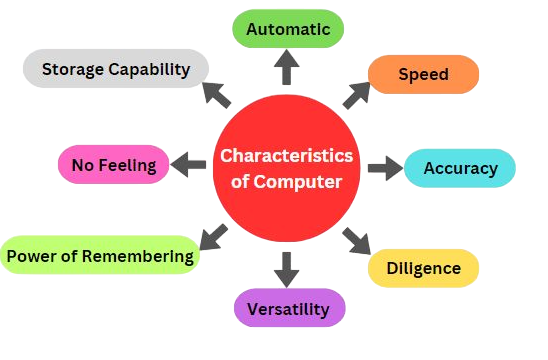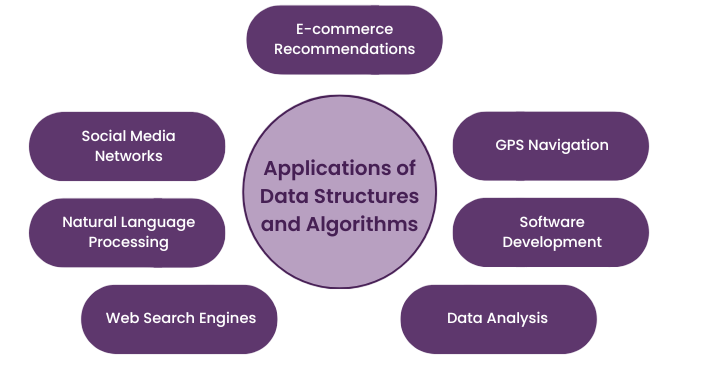
- Data Structures
- Importance in Computer Science
- Types: Linear vs Non-Linear
- Static vs Dynamic Data Structures
- Arrays, Linked Lists, Stacks, Queues
- Trees, Graphs, Heaps
- Abstract Data Types (ADT)
- Applications in Algorithms
- Choosing the Right Data Structure
- Real-World Use Cases
- Time and Space Trade-offs
- Conclusion
Data Structures
A data structure is a specialized format for organizing, processing, and storing data in a computer system. It provides a way to manage large amounts of data efficiently for various uses, such as searching, sorting, and updating information. By using the right data structure, software applications can perform tasks more effectively, making the system run faster and use memory more efficiently. Data structures range from simple ones like arrays and linked lists to complex ones like trees and graphs, each tailored for specific kinds of operations and performance requirements. To complement this foundational knowledge with hands-on development skills, exploring Web Developer Training reveals how mastering core technologies like HTML, CSS, JavaScript, and backend frameworks enables professionals to build optimized, data-driven web applications that translate theory into scalable solutions. Data structures are the foundation of computer science and programming. They enable computers to handle data in an organized and optimized manner, essential for efficient algorithm design and problem-solving. When developing software, developers must choose the most suitable data structure based on the type of operations the software is expected to perform. The study of data structures involves understanding how they work, how they are implemented, and when to use one over another.
To Earn Your Web Developer Certification, Gain Insights From Leading Web Developer Experts And Advance Your Career With ACTE’s Web Developer Courses Today!
Importance in Computer Science
In computer science, data structures are pivotal for solving problems efficiently. They are the building blocks that support efficient algorithm execution and system performance. For example, a well-implemented stack or queue can drastically simplify logic and reduce complexity.

In real-world applications such as search engines, social media platforms, and databases, data structures directly impact speed, scalability, and resource management. To complement these foundational structures with efficient build automation tools, exploring Graph Traversal in Data Structure reveals how each tool handles dependency management, performance optimization, and project configuration empowering developers to streamline builds and maintain scalable software systems. Mastery of data structures helps developers design algorithms with optimal time and space complexities, critical for applications where performance is a priority.
Types: Linear vs Non-Linear
Data structures are broadly categorized into two types: Linear vs Non-Linear. To complement this classification with practical timing control in programming, exploring Merge Sort Algorithm reveals how developers can using a technique often used in simulations, rate-limited loops, and dramatic output formatting across both linear and non-linear data processing workflows.
- Linear Data Structures: Elements are arranged in a sequential manner. Examples include arrays, linked lists, stacks, and queues. These structures are simple and easy to implement but may not be ideal for all use cases, especially when hierarchical relationships need to be modeled.
- Non-Linear Data Structures: Elements are not arranged in a sequential order. Instead, they are arranged in a hierarchical manner. Trees and graphs fall under this category. These are more complex but provide powerful tools for representing relationships and connections between data.
Linear vs Non-Linear each type has its strengths and is chosen based on the nature of the problem being addressed.
Would You Like to Know More About Web Developer? Sign Up For Our Web Developer Courses Now!
Static vs Dynamic Data Structures
Data structures can also be classified based on their ability to change size: static structures have fixed capacity, while dynamic structures can grow or shrink during runtime. To complement this classification with language-level implementation strategies, exploring Important Data Structures and Algorithms reveals how Kotlin’s statically typed nature and concise syntax contrast with Python’s dynamic flexibility each offering distinct advantages when managing memory, mutability, and performance in scalable applications.
- Static Data Structures: Have a fixed size defined at the time of creation. Arrays are a common example. Their simplicity allows for fast access times, but they can be inefficient when the size of data changes frequently.
- Dynamic Data Structures: Can grow or shrink during program execution. Examples include linked lists, stacks, and queues implemented with pointers. They are flexible and memory-efficient, especially when the size of data is unpredictable.
Choosing between static and dynamic data structures depends on the specific memory and flexibility requirements of the application.
Arrays, Linked Lists, Stacks, Queues
- Arrays: A collection of elements stored in contiguous memory locations. They offer fast access to elements using indexing but require predefined size.
- Linked Lists: Consist of nodes where each node contains data and a reference to the next node. They allow for efficient insertion and deletion but are slower in accessing elements compared to arrays.
- Stacks: Follow the Last-In-First-Out (LIFO) principle. Useful for function calls, undo mechanisms, and expression parsing.
- Queues: Follow the First-In-First-Out (FIFO) principle. Ideal for scheduling, task management, and buffer handling.
Each of these data structures is fundamental and forms the base for more advanced structures and algorithms.
Are You Interested in Learning More About Web Developer? Sign Up For Our Web Developer Courses Today!
Trees, Graphs, Heaps
Trees, graphs, and heaps are important non-linear data structures that help organize and manage data effectively. Trees have a hierarchical layout with a root node and child nodes. This makes them useful in various applications like databases and compilers. Types of trees include binary trees, binary search trees, AVL trees, and B-trees. Graphs, on the other hand, consist of vertices (or nodes) connected by edges. This structure is ideal for modeling complex relationships found in social networks and transportation systems. To complement this understanding of data structures with practical implementation skills, exploring Web Developer Training reveals how mastering technologies like JavaScript, React, and backend frameworks enables developers to build responsive, data-driven web applications that leverage hierarchical and relational models for real-world problem solving. Heaps are another specialized type of tree structure. They are used to create priority queues, with min-heaps and max-heaps playing key roles in algorithms like Dijkstra’s and in job scheduling tasks. These data structures together provide efficient solutions for problems related to relationships and hierarchy. They help streamline processes in many fields.
Abstract Data Types (ADT)
An Abstract Data Types (ADT) is a concept that describes how a data structure works without explaining how it is implemented. Several important ADTs are commonly used in programming. For example, a List is a sequence where elements are stored in order. A Stack is a collection that follows a Last In, First Out (LIFO) principle, which means the last item added is the first to be removed. In contrast, a Queue works on a First In, First Out (FIFO) basis, where the first item added is the first one to be removed. A Deque, or double-ended queue, allows insertion and deletion from both ends. To complement these data structure behaviors with efficient web development frameworks, exploring Spring Boot vs Spring MVC reveals how Spring Boot streamlines application setup with auto-configuration, while Spring MVC offers granular control over HTTP request handling each suited for different architectural needs in scalable Java applications. A Set is a collection that contains only unique items, while a Map is a collection of key-value pairs. Understanding these ADTs is essential because it helps in choosing or designing data structures that best suit specific operations, regardless of how they are managed internally.
Applications in Algorithms
Data structures are tightly coupled with algorithms. For example: efficient sorting relies on arrays and trees, while graph traversal depends on stacks, queues, or recursion. To complement these technical foundations with career-level insights, exploring Bubble Sort Algorithm reveals how mastering algorithmic logic, system design, and troubleshooting skills can lead to high-paying roles across software, hardware, and network engineering domains especially in India’s rapidly growing tech ecosystem.

- Sorting Algorithms: Arrays and linked lists are used in quick sort, merge sort, and bubble sort.
- Searching Algorithms: Binary search operates on arrays; depth-first and breadth-first searches work on trees and graphs.
- Dynamic Programming: Uses tables (often arrays) to store computed subproblem solutions.
- Graph Algorithms: Dijkstra’s, Kruskal’s, and Prim’s algorithms operate on graphs.
Efficient algorithms rely on the right data structures to minimize computational complexity and optimize performance.
Choosing the Right Data Structure
When building a software application, choosing the right data structure is key to improving both time and space efficiency. Start by thinking about the type of data you are working with, whether it is numeric, textual, hierarchical, or relational. Next, consider the operations you will often perform on this data, such as inserting, deleting, searching, or updating. It’s also crucial to consider the memory limits of your environment. Knowing how much RAM is available can significantly affect your decision. To complement these resource-aware decisions with efficient package management, exploring What is pip reveals how Python’s preferred installer program simplifies dependency handling allowing developers to install, upgrade, and manage modules with precision across constrained or scalable environments. Lastly, think about your access patterns: will your application need random access or mainly use sequential access? By making informed choices based on these factors, you can achieve noticeable performance gains, resulting in a better experience for users.
Real-World Use Cases
Data structures are everywhere:
- Social Media: Graphs represent user relationships; heaps manage trending content.
- E-Commerce: Queues manage order processing; arrays hold product listings.
- Navigation Systems: Graphs are used for shortest path algorithms.
- Compilers: Stacks handle syntax parsing and function calls.
- Databases: B-trees and hash tables support fast data retrieval.
Understanding these use cases reinforces the importance of learning and applying the correct data structure.
Time and Space Trade-offs
Every data structure has strengths and trade-offs: arrays offer fast indexing but limited flexibility, linked lists support dynamic memory but require sequential access, and trees enable hierarchical organization with efficient search operations. To complement these structural choices with runtime execution environments, exploring Node.js Installation on Windows reveals how setting up Node.js empowers developers to build scalable, event-driven applications leveraging JavaScript’s versatility across both client and server sides.
- Arrays: Fast access but fixed size.
- Linked Lists: Dynamic size but slow access.
- Trees: Balanced trees offer fast insert/search/delete but are complex to implement.
- Graphs: Powerful but can consume significant memory.
Balancing time complexity (how fast operations are) and space complexity (how much memory is used) is essential when choosing a data structure.
Conclusion
Data structures form the backbone of efficient programming. From simple arrays to complex graphs, they enable developers to manage data systematically and solve complex problems effectively. Whether it’s for algorithm implementation, application performance, or memory management, choosing the right data structure is critical. With advancements in technology and data-driven applications, a solid understanding of data structures remains indispensable in the field of computer science and software engineering. To complement this foundational knowledge with practical development expertise, exploring Web Developer Training reveals how mastering front-end and back-end technologies equips professionals to build efficient, data-driven web applications bridging theoretical concepts with real-world implementation. By mastering data structures, programmers can create robust, scalable, and high-performing applications for real-world challenges.





